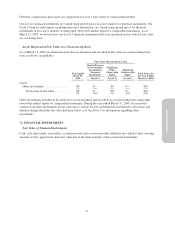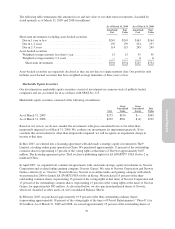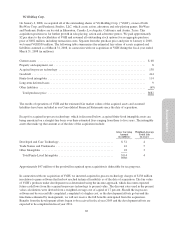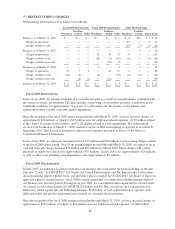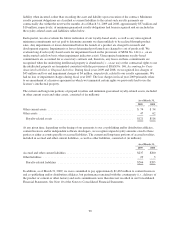Electronic Arts 2009 Annual Report Download - page 160
Download and view the complete annual report
Please find page 160 of the 2009 Electronic Arts annual report below. You can navigate through the pages in the report by either clicking on the pages listed below, or by using the keyword search tool below to find specific information within the annual report.Ubisoft (representing approximately 24 percent of the voting rights) in each year. Although we held 24 percent of
the voting rights of Ubisoft as of March 31, 2009 and 2008, respectively, we do not account for this investment
under the equity method of accounting because we do not have the ability to exercise significant influence over
the investee.
During fiscal years 2009 and 2008, we recognized impairment charges of $27 million and $81 million,
respectively, on our investment in The9 and $30 million and $28 million, respectively, on our Neowiz common
shares. Due to various factors, including but not limited to, the extent and duration during which the market price
had been below cost, we concluded the decline in values were other-than-temporary as defined by SFAS No. 115,
as amended. Subsequent to the end of fiscal year 2009, due to a change in The9’s business, the fair value of our
investment in The9 declined such that as of May 14, 2009 our adjusted cost basis exceeded its market value by
approximately $21 million. If the fair value of our investment in The9 does not improve from its current value,
we may be required to recognize additional impairment charges. In fiscal year 2009, we received a cash dividend
of $5 million from The9, offsetting our $27 million impairment charge. The $57 million and $109 million
impairments for the fiscal years ended March 31, 2009 and 2008, respectively, are included in losses on strategic
investments, net, on our Consolidated Statements of Operations. We did not recognize any impairment charges in
fiscal year 2007.
We did not have any realized gains or losses from the sale of marketable equity securities for the years ended
March 31, 2009, 2008 and 2007.
Other Investments Included in Other Assets
Our other investments consist principally of non-voting preferred shares in two companies whose common stock
is publicly traded and are accounted for under the cost method as prescribed by APB No. 18, as amended.
In April 2007, we purchased all of the then-outstanding non-voting preferred shares of Neowiz for approximately
$27 million and have included it in other assets on our Consolidated Balance Sheets. The preferred shares
became convertible at our option into approximately 4 percent of the outstanding voting common shares of
Neowiz in April 2008.
During fiscal years 2009 and 2008, we recognized impairment charges of $10 million and $9 million,
respectively, on our Neowiz preferred shares. Due to various factors, including but not limited to, the extent and
duration during which the fair value had been below cost, we concluded the decline in value was other-than-
temporary. The $10 million and $9 million impairments are included in losses on strategic investments, net, on
our Consolidated Statements of Operations. We did not recognize any impairment charges in fiscal year 2007.
(4) DERIVATIVE FINANCIAL INSTRUMENTS
In the fourth quarter of fiscal year 2009, we adopted SFAS No. 161, Disclosures about Derivative Instruments
and Hedging Activities — an amendment of SFAS No. 133, which requires enhanced disclosures about an entity’s
derivative and hedging activities, including how and why an entity uses derivative instruments, how derivative
instruments and related hedged items are accounted for under SFAS No. 133, Accounting for Derivative
Instruments and Hedging Activities, and how derivative instruments and related hedged items affect a company’s
financial position, financial performance and cash flows. We account for our derivative and hedging activities
under SFAS No. 133. The assets or liabilities associated with our derivative instruments and hedging activities
are recorded at fair value in other current assets or other current liabilities, respectively, in our Consolidated
Balance Sheets. As discussed below, the accounting for gains and losses resulting from changes in fair value
depends on the use of the derivative and whether it is designated and qualifies for hedge accounting.
We transact business in various foreign currencies and have significant international sales and expenses
denominated in foreign currencies, subjecting us to foreign currency risk. We purchase foreign currency option
contracts, generally with maturities of 15 months or less, to reduce the volatility of cash flows primarily related
to forecasted revenue and expenses denominated in certain foreign currencies. In addition, we utilize foreign
80









